International Journal of Neutrosophic Science (IJNS)
Plithogenic n- Super Hypergraph in Novel Multi -Attribute Decision Making

Florentin Smarandache 1* and Nivetha Martin 2
1 Department of Mathematics, University of New Mexico, Gallup, NM 87301,USA, smarand@unm.edu
2 Department of Mathematics, Arul Anandar College (Autonomous), Karumathur, India nivetha.martin710@gmail.com
* Correspondence: smarand@unm.edu
An optimal decision making environment demands feasible Multi Attribute Decision Making methods. Plithogenic n Super Hypergraph introduced by Smarandache is a novel concept and it involves many attributes. This article aims to bridge the concept of Plithogenic n Super Hypergraph in the vicinity of optimal decision making. This research work introduces the novel concepts of enveloping vertex, super enveloping vertex, dominant enveloping vertex, classification of the dominant enveloping vertex (input, intervene, output dominant enveloping vertices), plithogenic connectors. An application of Plithogenic n super hypergraph in making optimum decisions is discussed under various decision making scenarios. Several insights are drawn from this research work and will certainly benefit the decision makers to overcome the challenges in building decisions.
Keywords: Plithogenic n super hypergraph, decision making, attributes, dominant enveloping vertex.
1.Introduction
It is quite inevitable for each one is taking up the role of decision maker in their instances of life. Decision making isn’t an activity, but a process comprising of many tasks. The desired outcomes of decisions are a success, if it fails then the process has to be revived. The cognitive contribution in choosing the best alternative with the consideration of criteria and criteria weights is not a simple task; it demands sequential steps and scientific approach. The managerial of either a start up company or a multinational organization must possess the skills of making optimal decisions to make their companies march in the path of victory. The decision making environment is not deterministic always and it is characterized mostly by uncertainty and impreciseness, to tackle these challenges the decision makers are moving towards Multi Criteria Decision Making methods (MCDM) to design optimal solutions.
Vol. 7, No. 1, PP. 08 30, 2020 DOI: 10.5281/zenodo.3876206
International Journal of Neutrosophic Science (IJNS)
MCDM has been explored for the past seventy years and it has been broadly divided into MADM (Multi Attribute Decision Making) and MODM (Multi Objective Decision Making) [1]. The former helps in the selection of the alternatives based on attribute description and the latter is based on optimization of decision maker’s multi objectives. MADM methods are gaining impetus in the decision making environment as they are highly developed with robust mathematical principles and also these methods prevent small and medium sized companies in purchasing expensive software or executing erudite systems of the decision process. MADM methods are more operative and the most widely used methods are Analytic Hierarchy Process (AHP) and Analytic Network Process (ANP) introduced by Satty [2]; Decision Making Trial and Evaluation Laboratory (DEMATEL) developed by Tzeng and Huang [3]; The Technique for Order Preferences by Similarity to an Ideal Solution (TOPSIS) method was proposed by Hwang and Yoon; Vlse Kriterijumska Optimizacija I Kompromisno Resenje (VIKOR) method was developed by Tzeng and Huang. In the above described MADM methods, the major steps involved are (i) formulation of initial decision making matrix (IDMM) comprising of values representing the degree of fulfilling the criteria by the alternatives. (ii) Normalization of the values in IDMM (iii) Determination of criterion weight (iv) Ranking of alternatives. In these MADM methods, the alternatives are ranked based only on the extent of criteria satisfaction, but the consistency of ranking is not checked as these methods do not provide space for it. The selection of alternatives is based only on attribute satisfaction and it does not consider any other input such as previous data related to the impacts or the effects of these kinds of chosen alternatives. These other inputs are not brought into the decision making environment and the previous feedback review is also not incorporated into the decision making environment. Let us consider the possible situations of exercising decision making in a company, for example in the selection of personnel, methods of production, the extension of product features, the above instances of decision making situations are not new to companies, as these processes are routine. In making decisions, certainly the managerial will be aware of the desired target to be achieved and will employ his previous experience or the feedback received by him from various sources as inputs in the selection of alternatives. The above said MADM does not provide space for such kinds of feedback inputs. A comprehensive decision making environment must comprise of alternative selection based on several inputs such as attribute satisfaction, feedback, and impact of attributes towards the desired output. To overcome such shortcomings, a novel MADM method is introduced in this research work with the integration of Plithogenic super Hypergraphs introduced by Smarandache [4]. Plithogenic sets introduced by Smarandache [5] are the extension of neutrosophic sets that are characterized by truth, indeterminacy, and false functions. The robust nature of neutrosophic sets inspired several researchers to employ it in diverse fields. Gayathri et al [6] developed multiple attribute group decision making neutrosophic environments with the utilization of Jaccard index measures. Muhammad Naveed Jafar et al [7] used neutrosophic soft matrices with score function to evaluate new technology in Agriculture. Ajay et al [8] developed a single valued triangular neutrosophic number approach of multi objective optimization based on simple ratio analysis based on the MCDM method. Luis Andrés Crespo Berti [9] applied a neutrosophic system to tax havens with a criminal approach. Abdel Basset [10] developed three way decisions based on neutrosophic sets and AHP QFD framework for supplier selection problem, also developed a hybrid neutrosophic group ANP TOPSIS framework for supplier selection
Vol. 7, No. 1, PP. 08 30, 2020 DOI: 10.5281/zenodo.3876206
International Journal of Neutrosophic Science (IJNS)
Vol. 7, No. 1, PP. 08 30, 2020
problem [11].Plithogenic sets that deal with attributes, degree of appurtenance, and degree of contradiction have been extensively used in decision making with quality function deployment for selecting supply chain sustainability metrics and for evaluating hospital medical care systems by Abdel Basset et al [12,13]. In these decision making approaches plithogenic aggregation operations are used to make decisions based on the best and worst criteria with decision makers' opinions as inputs. These methods of decision making focus primarily on evaluation and selection of alternatives based on combining plithogenic aggregation operators and do not provide space for any graphical representation of the relational impacts between the alternatives.
In the proposed MADM each alternative is considered as an object encompassing several attributes. The decision making environment consists of three kinds of objects namely input, intervention, and output. The alternatives are taken as inputs, desired target as output, and intervene (intermediate) objects are the objects that combine with the input objects. A company always works on target based. Personnel design project and work on it tirelessly to achieve various sets of goals. The project never gets accomplished with the attainment of a single goal but a series of goals. The success of a project is defined in various dimensions. In the proposed MADAM, the selection of alternatives is based on the degree of association between the attributes of inputs and the attributes of outputs independent or dependent on intervening objects. This decision making approach is more comprehensive than the conventional MADM methods as it incorporates attributes and feedback into the input system. Also, many times the company prefers collaborative works and the effects of combined initiatives are high. Conventional MADM does not provide space for it, but the proposed MADM is designed exclusively for measuring the optimal combination. Also in MADM methods, graphical representations are not made so far to represent alternatives, criteria, and their relationship. In this novel MADM, plithogenic n super hypergraphs are used to represent the objects as enveloping vertices and the association between the vertices by plithogenic connectors.
The article is structured as follows: Section 2 introduces new concepts used in novel MADM; section 3 presents the application of novel MADM in optimal decision making; section 4 discusses the results and the last section concludes the work.
2. Preliminaries
2.1 Enveloping vertex
A vertex representing an object comprising of attributes and sub attributes in the graphical representation of a multi attribute decision making environment.
For instance
Let us consider Personnel (V) as an input object, this input has a vital role in target achievement, the output object. These attributes are like databases
The attributes like Qualification (V1), Age (V2), Experience (V3) are taken into consideration
Attribute sets = {Qualification, Age, Experience}
Qualification = {Graduation, Graduation with additional degree}
Age = {25 35, 36 45}
Experience = { Local, National ,International }
DOI: 10.5281/zenodo.3876206
International Journal of Neutrosophic Science (IJNS)
Local {0 5,6 10}, National{0 3,4 6}, International {0 2,2 5}
Vol. 7, No. 1, PP. 08 30, 2020
Fig.2.1Enveloping vertex
Thus an enveloping vertex comprises hyperedges, where each hyperedge represents values of the attributes.
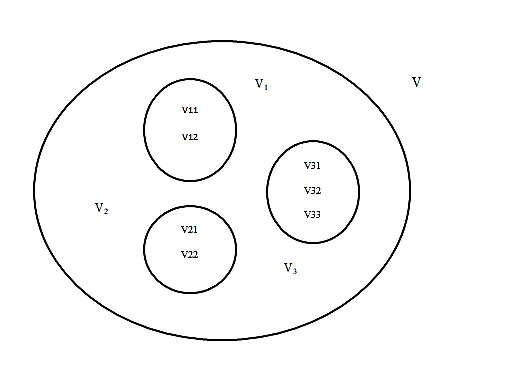
2.2 Super Enveloping vertex
An enveloping vertex comprises of Super hyper edges
Fig.2.2 Super Enveloping vertex
DOI: 10.5281/zenodo.3876206
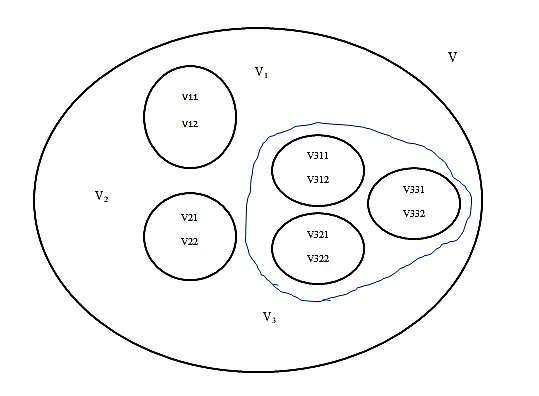
International Journal of Neutrosophic Science (IJNS)
2.3
Dominant Enveloping Vertex
An enveloping vertex is with dominant attribute values
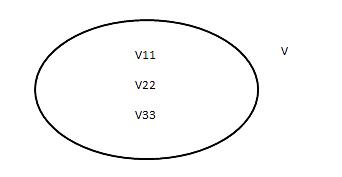
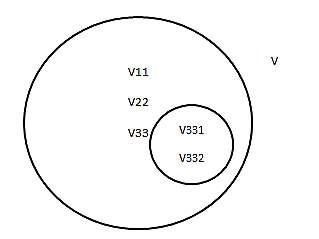
Attribute sets = {Qualification, Age, Experience}
The dominant attribute values
Qualification = {Graduation, Graduation with additional degree} Age = {25 35, 36 45}
Experience = { Local, National ,International }
Fig.2.3 Dominant Enveloping Vertex
2.4 Dominant Super Enveloping Vertex
A super enveloping vertex with dominant attribute values
Attribute sets = {Qualification, Age, Experience}
The dominant attribute values
Qualification = {Graduation, Graduation with additional degree} Age = {25 35, 36 45}
Experience = { Local, National ,International } Local {0 5,6 10}, National{0 3,4 6}, International {0 2,2 5}
Vol. 7, No. 1, PP. 08 30, 2020
Fig.2.4 Dominant Super Enveloping Vertex
DOI: 10.5281/zenodo.3876206
International Journal of Neutrosophic Science (IJNS)
2.5 Classification of Dominant Enveloping Vertex
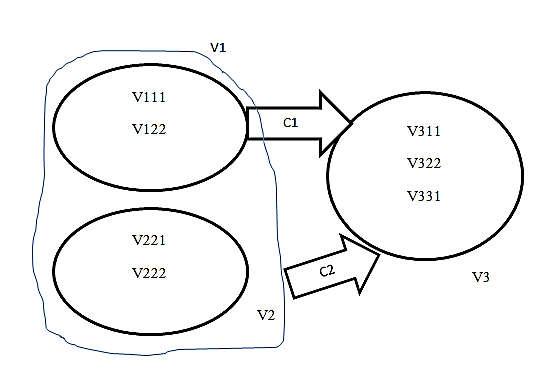
Vol. 7, No. 1, PP. 08 30, 2020
The dominant enveloping vertex set are classified as input, intervene and output based on the nature of object’s representation.
2.6 Plithogenic Connectors
The connectors associate the input enveloping vertex with output enveloping vertex. These connectors associate the effects of input attributes to output attributes and these connectors are weighted by plithogenic weights.
Let us consider the MADM environment with the product as input object, advertising as intervene object and product success as the output object
Product is the input enveloping vertex, advertising as intervening enveloping vertex and product success as the output enveloping vertex.
Input attributes = {Design, Price}
Design = {creative, conventional}
Price = {High, moderate, low}
Intervene attributes = { Target group, Medium of advertising}
Target group ={female, children}
Medium of advertising = { social networks, media}
Output Attributes = { Profit, Customer Acquisition, Product Reach}
Profit = { Expected, Beyond the target}
Customer Acquisition = { High, Extremely High}
Product Reach = { National, International}
Fig.2.5 Plithogenic Connectors
C1 is the simple plithogenic connector representing the relation between the dominant input attributes to dominant output attributes.
DOI: 10.5281/zenodo.3876206
International Journal of Neutrosophic Science (IJNS)
Vol. 7, No. 1, PP. 08 30, 2020
C2 is the combined plithogenic connector representing the relation between the combined dominant input and intervene attributes to dominant output attributes.
Dominant Attribute Relational Matrix Representation
V311 V322 V331
V111 0.5 0.2 0.3 V122 0.6 0.7 0.8
V111,V221 0.5 0.6 0.4
V111,V222 0.6 0.3 0.8 V122,V221 0.4 0.6 0.8 V122,V222 0.4 0.6 0.7
3. Application of Novel MADM method
3.1
Description of Decision-making Environment
COVID 19 has locked the academic activities to a great extent; the stratagem of Work from Home is employed by the teaching fraternity to engage the learners. One of the biggest challenges to teaching community lies in handling online learning forums and they are badly in need of exposure to the E learning system of education. To make academicians surpass this task, educational institutions are offering various online courses and organize E programmes to enhance the professional competency of faculty in partnership with several industries. In this period of the lockdown, the linkage between industries and institutions is getting enhanced in developing countries especially in India. The companies enter institutions as academic partners in establishing virtual laboratories and entertain many online programs in the form of webinars, online courses, and software training programs to handle online classes. The conduct of such programs will certainly contribute to the professional efficiency of faculty. Suppose if an institution decides to conduct any one of the forms of the online program, then it has to decide whether to conduct the program in partnership with industry or independently and also the decision of selecting the kind of online program is based on the feedback acquired from other institutions on the previous organization of such programs. The institution before organizing such programs should decide the component of professional efficiency to be enhanced and determine the contributing factors of the online program towards the same. An optimal solution to this decision making situation is determined by using the representation of Plithogenic n Super hypergraph and novel MADM method based on attributes. This decision making method involves not only the selection process of alternatives based on criteria alike other multi attribute decision making methods but it provides space for the selection of alternatives independent or dependent on other alternatives based on their attributes. The outcome of decision making is also considered in the decision making process. The selection of the alternatives is based on attributes of input objects, intervene objects and output objects.
In this decision making environment there exist five objects [3 input objects, 1 intervene object and 1 output object] that are represented by enveloping vertices. The input enveloping vertices are Webinars, online
DOI: 10.5281/zenodo.3876206
International Journal of Neutrosophic Science (IJNS)
Vol. 7, No. 1, PP. 08 30, 2020
courses, training programs on computer languages, intervene enveloping vertex is Industrial partnership and the output enveloping vertex is Professional Efficiency. The description of the attributes of the objects are presented in Table 3.1
Table 3.1 Description of Attributes
Vertex Representation
Vertex Attributes
Vertex Sub Attributes
V1 Webinars
DOI: 10.5281/zenodo.3876206
V11 Focus
V111 General
V1111 Education V1112 Health V1113 Psychology V112 Specific
V1121 Physics V1122 Chemistry V1123 Mathematics V1124 Engineering V12 Resource persons
V121 Local V1211 within the college V1212 neighboring colleges V122 National V1221 AICTE affiliated V1222 Non AICTE affiliated V123 International
V1231 Affiliation with the host college V1232 Non affiliation with the host college
V131 Day
V13 Duration
V1311 One day V1312 Two days V1313 Three days V132 Week V1321 One V1322 Two V14 Target Group V141 Students V1411 Engineering V1412 Non Engineering
International Journal of Neutrosophic Science (IJNS)
Vol. 7, No. 1, PP. 08 30, 2020
V142 Research Scholars V1421 Engineering V1422 Non Engineering
V143 Academicians V1431 Engineering V1432 Non Engineering
V21 Course nature V211 Basic
V212 Moderate
V2111 remembrance V2112 understanding
V2121 understanding V2122 application
V2 Online courses
V3
DOI: 10.5281/zenodo.3876206
V213 Advanced V2131 Analysis V2132 Evaluation V22 Course Delivery
V221 Synchronous
V2211 Zoom V2212 Zoho V2213 Examineer V2214 Google meet
V222 Asynchronous V2221 Google Classroom V2222 Youtube upload V23 Duration
V231 Day
V2311 One day V2312 Two days V2313 Three days
V232 Week V2321 One V2322 Two V24 Target Group
V241 Students V2411 Engineering V2412 Non Engineering
V242 Research Scholars V2421 Engineering V2422 Non Engineering
V243 Academicians V2431 Engineering V2432 Non Engineering
Training programme on Computer languages V31 Course nature V311 Basic
V3111 remembrance V3112 understanding
V312 Moderate V3121 understanding
International Journal of Neutrosophic Science (IJNS)
Vol. 7, No. 1, PP. 08 30, 2020
V3122 application
V4
Industrial Partnership
DOI: 10.5281/zenodo.3876206
V313 Advanced V3131 Analysis V3132 Evaluation V32 Course Delivery
V321 Synchronous
V3211 Zoom V3212 Zoho V3213 Examineer V3214 Google meet
V322 Asynchronous V3221 Google Classroom V3222 Youtube upload V33 Duration
V331 Day
V3311 One day V3312 Two days V3313 Three days
V332 Week V3321 One V3322 Two V34 Target Group
V341 Students V3411 Engineering V3412 Non Engineering V342 Research Scholars V3421 Engineering V3422 Non Engineering V343 Academicians V3431 Engineering V3432 Non Engineering
V41 MOU V411 Internship
V412 Placement
V42 Financial Support
V4111 Merit based V4112 All students
V4121 Merit based V4122 All students
V4211 Partial V4212 Complete V422 Program organization V4221 Partial V4222 Complete V431 Knowledge sharing V4311 Periodic
V421 Equipment purchase
International Journal of Neutrosophic Science (IJNS)
V43 Technical Support
V5 Professional Efficiency
Vol. 7, No. 1, PP. 08 30, 2020
V4312 Regular
V432 Experts Visit V4321 Periodic V4322 Regular
V51 Publications V511 National
V5111 Scopus V5112 ICI
V5121 Scopus V5122 ICI V52 Pedagogy
V53 Content preparation
V512 International
V521 Teacher Centered V5211 lecture V5212 chalk & talk V522 Learner Centered V5221 Blended V5222 ICT
V531 Own V5311 original V5312 modified V532 Experts Visit V5321 Web sources V5322 Youtube
V541 OER
V54 Course Delivery
V5411 Zoom V5412 Zoho V5413 Google meet V5414 Examineer
V542 Asynchronous V5421 Google Classroom V5422 Youtube upload
In the above table, the input objects such as webinars, online courses, training programs are represented as the input enveloping vertices V1, V2, and V3 in Fig 3.1,3.2 and 3.3 respectively. The intervening object Industrial Partnership is represented as V4 in Fig 3.4. The output object Professional Efficiency is represented as V5 in Fig 3.5.
DOI: 10.5281/zenodo.3876206
International Journal of Neutrosophic Science (IJNS)
Vol. 7, No. 1, PP. 08 30, 2020
Fig.3.1 Representation of Input Object V1
Fig.3.2 Representation of Input Object V2
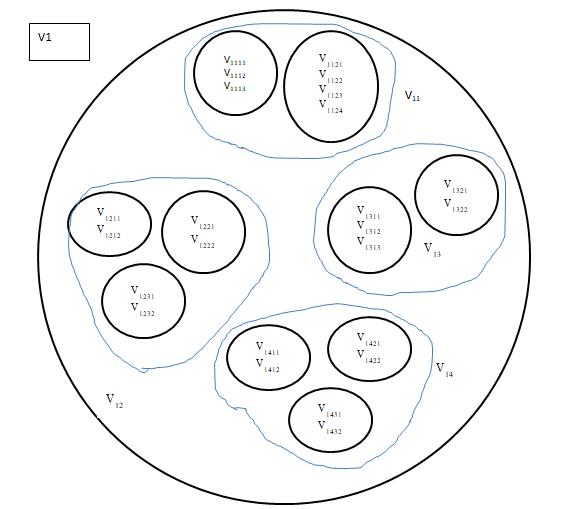
DOI: 10.5281/zenodo.3876206
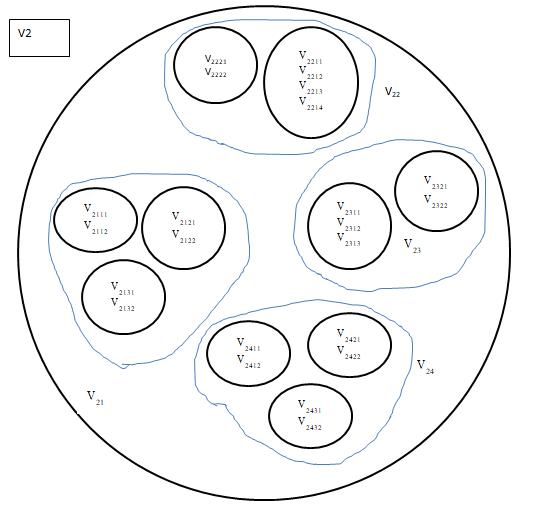
International Journal of Neutrosophic Science (IJNS)
Vol. 7, No. 1, PP. 08 30, 2020
Fig.3.3 Representation of Input Object V3
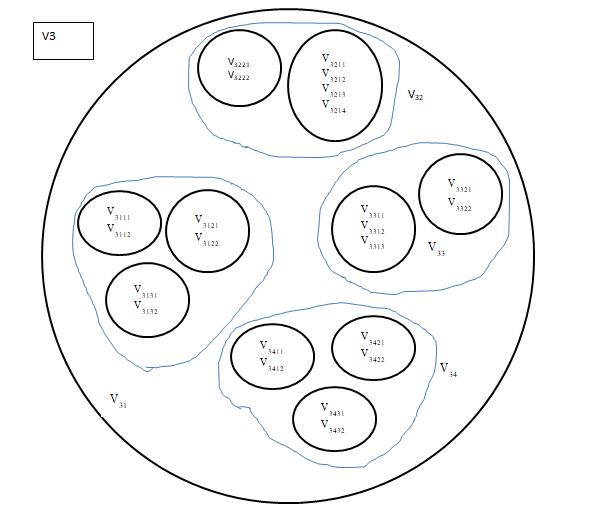
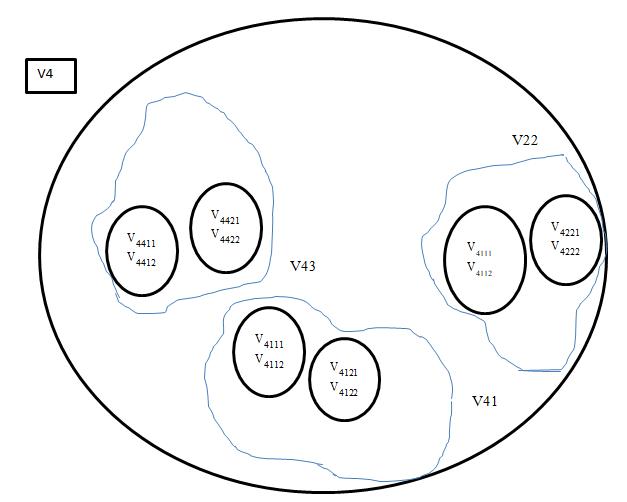
DOI: 10.5281/zenodo.3876206
Fig.3.4 Representation of Intervening Object V4
International Journal of Neutrosophic Science (IJNS)
Fig.3.5 Representation of
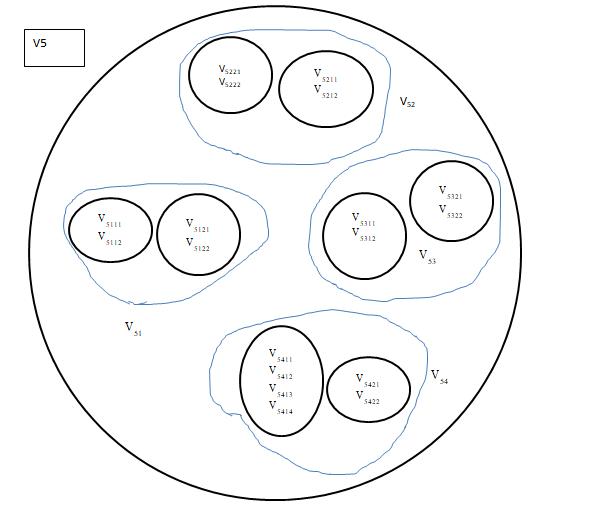
Object
Table 3.2 Representation of Dominant Attributes
Vol. 7, No. 1, PP. 08 30, 2020 DOI: 10.5281/zenodo.3876206
International Journal of Neutrosophic Science (IJNS)
Vol. 7, No. 1, PP. 08 30, 2020
V2 Online courses Course Nature, V21 Course nature V212 Moderate V2122 application
V22 Course Delivery
V222 Asynchronous V2221
Google Classroom V23 Duration V231 Day V2312 Two days V24 Target Group V243 Academicians V2431 Engineering
V3 Training program on Computer languages V31 Course nature V311 Moderate V3122 application V32 Course Delivery
V321 Synchronous V3214
Google meet
V33 Duration V332 Week V3321 One V34 Target Group V343 Academicians V3431 Engineering
V4 Industrial Partnership V41 MOU V412 Placement V4121 Merit based V4122 All students V42 Financial Support
V422 Program organization V4222
Complete V43 Technical Support
V432 Experts Visit V4322 Regular V4312 Regular
V5 Professional Efficiency V51 Publications V511 National V5111 Scopus V52 Pedagogy V522 Learner Centered V5221
Blended V53 Content preparation
original V54 Course Delivery V542 Asynchronous V5421 Google Classroom
The Dominant Enveloping vertices are presented in Fig 3.6
DOI: 10.5281/zenodo.3876206
V531 Own V5311
International Journal of Neutrosophic Science (IJNS)
Fig. 3.6 Dominant Enveloping vertices
3.1 Decision Making Scenario I
The institution is certain of the dominant sub attributes and makes decisions based on dominant attributes of the input objects. The graphical representation of attribute relation between input dominant enveloping vertices and the output dominating attribute vertex with simple plithogenic fuzzy connectors is presented in Fig 3.7
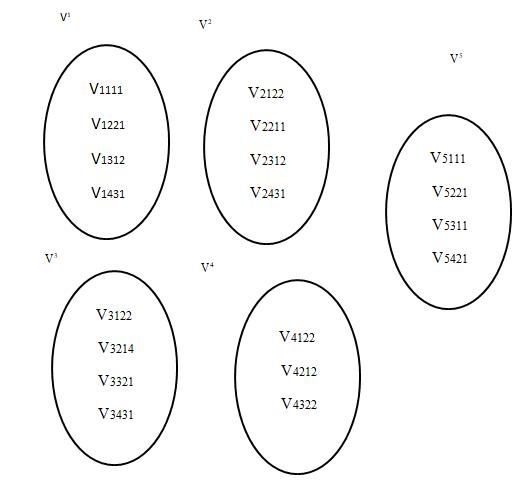
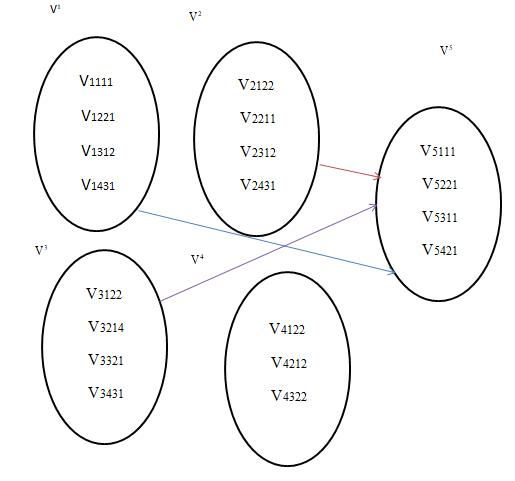
Fig.3.7 Representation of Decision Making Scenario I
Vol. 7, No. 1, PP. 08 30, 2020 DOI: 10.5281/zenodo.3876206
International Journal of Neutrosophic Science (IJNS)
Vol. 7, No. 1, PP. 08 30, 2020
The dominant attribute relational matrix representation between the input objects on the output objects is presented as follows
V5111 V5221 V5311 V5421
V1111 0.55 0.2 0.5 0.6 V1221 0.8 0.5 0.5 0.8
V1312 0.75 0.6 0.6 0.9 V1431 0.65 0.8 0.1 0.4
V2122 0.5 0.9 0.3 0.6 V2211 0.3 0.5 0.6 0.8 V2312 0.45 0.4 0.4 0.9
V2431 0.6 0.8 0.2 0.4 V3122 0.85 0.2 0.8 0.8 V3214 0.9 0.3 0.9 0.9 V3321 0.5 0.55 0.5 0.4 V3431 0.6 0.8 0.2 0.4
The frequency matrix as discussed by [14] shall be constructed to rank the dominant attributes of input objects contributing to the dominant attribute of the output object. This is a simple decision making environment as it does not involve the role of an intervening object.
3.2 Decision Making Scenario II
The institution is certain of the dominant sub attributes and makes decisions based on dominant attributes of the input and intervene objects. The graphical representation of attribute relation between input and intervene dominant enveloping vertices and the output dominating attribute vertex with combined plithogenic fuzzy connectors is presented in Fig.3.8
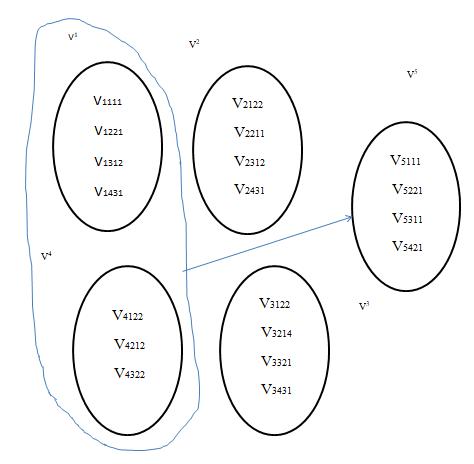
DOI: 10.5281/zenodo.3876206
Fig.3.8 Representation of Decision Making Scenario II
International Journal of Neutrosophic Science (IJNS)
Vol. 7, No. 1, PP. 08 30, 2020
The dominant attribute relational matrix representation between the input and intervene objects on the output objects is presented as follows
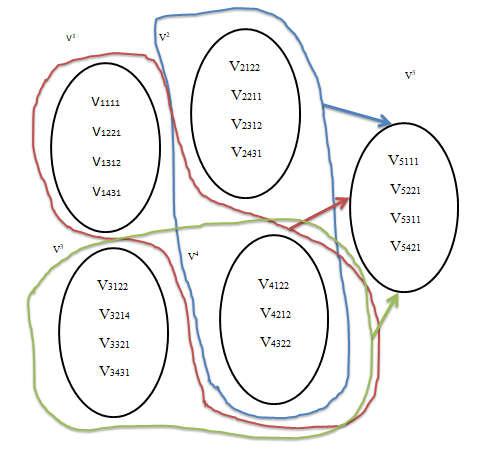
V5111 V5221 V5311 V5421
V1111,V4122 0.65 0.6 0.5 0.6 V1111,V4212 0.8 0.65 0.7 0.8 V1111,V4322 0.56 0.7 0.9 0.6 V1221,V4122 0.75 0.8 0.85 0.6 V1221,V4212 0.9 0.6 0.95 0.8 V1221,V4322 0.6 0.8 0.45 0.9 V1312,V4122 0.53 0.7 0.75 0.7 V1312,V4212 0.43 0.5 0.6 0.7 V1312,V4322 0.5 0.6 0.78 0.7
V1431,V4122 0.62 0.85 0.8 0.69 V1431,V4212 0.67 0.78 0.7 0.63 V1431,V4322 0.6 0.89 0.58 0.7
The frequency matrix shall be constructed to rank the combined dominant attributes of input and intervene objects contributing to the dominant attribute of the output object. This is a little complex decision making environment as it involves the role of an intervening object. Fig 3.9 presents the graphical representation of it.
Fig.3.9 Representation of Decision-Making Scenario II with Intervening object
3.3 Decision Making Scenario III
The institution is certain of the dominant sub attributes. Let us consider a situation, suppose if the institution decides to conduct a webinar with a focus on general, but not able to decide whether to give priority to Education, Health or Psychology, then the decision making environment becomes more complex. The graphical representation
DOI: 10.5281/zenodo.3876206
International Journal of Neutrosophic Science (IJNS)
of all sub attribute relation between input and the output dominating attribute vertex with simple plithogenic fuzzy connectors is presented in Fig. 3.10
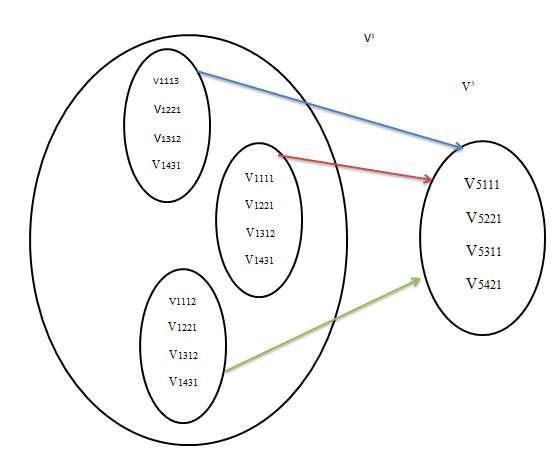
Fig. 3.10 Representation of Decision Making Scenario III
The dominant attribute relational matrix representation is as follows
V5111 V5221 V5311 V5421 V1111 0.55 0.2 0.5 0.6 V1112 0.6 0.55 0.7 0.85 V1113 0.5 0.3 0.6 0.6 V1221 0.8 0.4 0.4 0.8 V1312 0.7 0.64 0.6 0.9 V1431 0.6 0.89 0.62 0.4 V2122 0.54 0.9 0.73 0.6 V2211 0.83 0.5 0.6 0.8 V2312 0.4 0.4 0.45 0.9 V2431 0.6 0.8 0.72 0.49 V3122 0.9 0.52 0.8 0.8 V3214 0.95 0.63 0.9 0.9 V3321 0.5 0.8 0.5 0.43 V3431 0.6 0.8 0.52 0.4
3.4 Decision Making Scenario IV
This decision making situation is characterized when the institution is uncertain of the dominant sub attribute values of the input object. Suppose if the institution decides to conduct a webinar with focus on general, but not able to decide whether to give priority to Education, Health or Psychology, In this case, the dominant sub attribute value is not certain and suppose it wishes to collaborate with the industry then the decision making environment becomes highly complex. Fig 3.11 presents this graphically
Vol. 7, No. 1, PP. 08 30, 2020 DOI: 10.5281/zenodo.3876206
International Journal of Neutrosophic Science (IJNS)
Vol. 7, No. 1, PP. 08 30, 2020
Fig.3.11 Representation of Decision Making Scenario IV
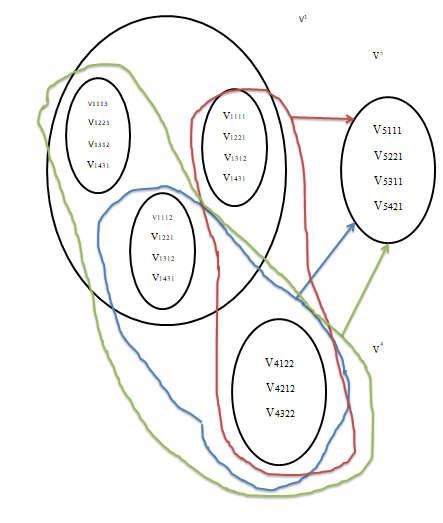
The dominant attribute relational matrix representation is as follows
V5111 V5221 V5311 V5421 V1111,V4122 0.65 0.6 0.5 0.6 V1111,V4212 0.8 0.65 0.7 0.8 V1111,V4322 0.56 0.7 0.9 0.6 V1112,V4122 0.52 0.68 0.57 0.66 V1112,V4212 0.45 0.67 0.72 0.56 V1112,V4322 0.56 0.68 0.74 0.69 V1113,V4122 0.67 0.79 0.83 0.79 V1113,V4212 0.57 0.82 0.74 0.68 V1113,V4322 0.5 0.7 0.7 0.6 V1221,V4122 0.75 0.8 0.85 0.6 V1221,V4212 0.9 0.6 0.95 0.8 V1221,V4322 0.6 0.8 0.45 0.9 V1312,V4122 0.53 0.7 0.75 0.7 V1312,V4212 0.43 0.5 0.6 0.7 V1312,V4322 0.5 0.6 0.78 0.7 V1431,V4122 0.62 0.85 0.8 0.69 V1431,V4212 0.67 0.78 0.7 0.63 V1431,V4322 0.6 0.89 0.58 0.7
The ranking of the attributes contributing to Professional efficiency corresponding to each decision making environment is presented in Table 3.3
DOI: 10.5281/zenodo.3876206
International Journal of Neutrosophic Science (IJNS)
Table 3.3 Ranking of the attributes
Ranking of the Attributes contributing to Professional Efficiency Decision Making Scenario I
Decision Making Environment
V1312 >V1221>V3122>V1221>V2122> V2211>V2431 >V1111>V2312>V1431>V3431>V3321 Decision Making Scenario II V1221,V4212>V1221,V4322>V1431,V4122>V1111,V4212 ,V1221 ,V4122>V1431, V4322 >V1312,V4122>V1312,V4322>V1111,V4122>V1312 ,V4212
Decision Making Scenario III V3214 >V2431>V1312>V2122>V3122 >V1111>V2211>V1431>V1221 >V3431> V3321 >V2312>V1112>V1113
Decision Making Scenario IV
4. Discussion
V1221,V4212 > V1113,V4122 > V1221,V4122> V1431,V4122> V1111,V4212 > V1113,V4212> V1431,V4212> V1431,V4322> V1111 ,V4322> V1221,V4322> V1312,V4122 > V1112,V4322 > V1312,V4322> V1113,V4322> V1112,V4122 > V1112,V4212> V1111,V4122> V1312,V4212
The ranking of the input attribute values of the dominant attributes contributing to the output dominant attribute values shows the significance of the individual contribution of each input attribute value. In the first decision making scenario, the attribute values of the input object are ranked. In the second decision making a scenario the combined attribute values of input and intervene objects are ranked. This helps in finding the combined effect towards the attainment of the output attribute values. In the third decision making scenario, the ranking of sub attribute values are made, in this case, there was a choice to choose between Education (V1111), Health (V1112) or Psychology (V1113 ), but the preference s should be given to Education based on the ranking. In the fourth decision making scenario, the combined effects of sub attribute values along with intervening attribute values are ranked and here also the combined effect of the sub attribute value, Education is gaining more significance. The above decision making scenarios were focusing on the effects of one input object and the same can be applied to other input objects and the respective results can be determined. The same method of decision making can be applied to production sectors in strategy selection which considers many attribute values and sub attribute values and this proposed plithogenic n superhypergraph MADM can be applied in such decision making scenario.
5. Conclusion
This article presents the application of plithogenic n super hypergraph in the context of optimal decision making. This research work introduces many new concepts such as enveloping vertex, dominant enveloping vertex, super enveloping vertex, and plithogenic connectors. This research work creates a new avenue in MADM by providing space for comprehensive decision making. A new approach to ranking the attribute values based on the frequency matrix is initiated. The theoretical description of plithogenic n super hypergraph is translated into practical application in this research work and this will certainly open new vistas of research. This work can be further extended with various plithogenic sets.
References
Vol. 7, No. 1, PP. 08 30, 2020 DOI: 10.5281/zenodo.3876206
[1] Ishizaka, A., Labib, A.. "Review of the main developments in the analytic hierarchy process", Expert Systems with Applications, Vol 38, pp.14336 14345, 2011.
[2] Saaty, T. L., "A scaling method for priorities in hierarchical structures",Journal of Mathematical Psychology. Elsevier: Amsterdam, Vol 15, pp.234 281, 1977.
International Journal of Neutrosophic Science (IJNS)
Vol. 7, No. 1, PP. 08 30, 2020
[3] Tzeng, G.H.; Huang, J.J. "Multiple Attribute Decision Making: Methods and Applications"; CRC Press: Boca Raton, FL, USA, 2011.
[4] Smarandache, Florentin., "Extension of HyperGraph to n SuperHyperGraph and to Plithogenic n SuperHyperGraph, and Extension of HyperAlgebra to n ary (Classical /Neutro /Anti )HyperAlgebra" Neutrosophic Sets and Systems, Vol 33, pp 290 296, 2020
[5] Smarandache, F. “Extension of Soft set to Hypersoft Set, and then to Plithogenic Hypersoft Set ” , Neutrosophic set and Systems, 22, pp.68 70, 2018.
[6] Gayathri.N., Helen.M., Mounika.P., "Utilization of Jaccard Index Measures on Multiple Attribute Group Decision Making under Neutrosophic Environment", International Journal of Neutrosophic Science,Vol. 3, pp 67 77, 2020.
[7] Muhammad Naveed Jafar.,Muhammad Saqlain., Ahmad Raza Shafiq., Muhammad Khalid., Hamza Akbar., Aamir Naveed., " New Technology in Agriculture Using Neutrosophic Soft Matrices with the Help of Score Function ", International Journal of Neutrosophic Science,Vol. 3,pp 78 88, 2020.
[8] Ajay.D.,Aldring.J.,Abirami.S.,Jeni Seles Martina.D., " A SVTrN number approach of multi objective optimization on the basis of simple ratio analysis based on MCDM method ", International Journal of Neutrosophic Science ,Vol. 5, pp 16 28, 2020.
[9] Luis Andrés Crespo Berti.,"Application of the neutrosophic system to tax havens with a criminal approach",International Journal of Neutrosophic Science ,Vol. 5, pp.91 106, 2020.
[10] Abdel Basset, M., Manogaran, G., Mohamed, M., Chilamkurti, N., "Three way decisions based on neutrosophic sets and AHP QFD framework for supplier selection problem". Future Gener. Comput. Syst. Vol 89, pp.19 30,2018.
[11] Abdel Basset, M., Mohamed, M., Smarandache, F., "A hybrid neutrosophic group ANP TOPSIS framework for supplier selection problems". Symmetry Vol 10, pp 226, 2018.
[12] Abdel Basset, M., El hoseny, M., Gamal, A., & Smarandache, F., "A novel model for evaluation Hospital medical care systems based on plithogenic sets". Artificial intelligence in medicine, 100, 101710,2019
[13] Abdel Basset, M., Mohamed, R., Zaied, A. E. N. H., & Smarandache, F.,"A hybrid plithogenic decision making approach with quality function deployment for selecting supply chain sustainability metrics" Symmetry, Vol 11,903,2019.
[14] Shazia Rana ., Madiha Qayyum.,Muhammad Saeed., Florentin Smarandache, Bakhtawar Ali Khan., "Plithogenic Fuzzy Whole Hypersoft Set, Construction of Operators and their Application in Frequency Matrix Multi Attribute Decision Making Technique", Neutrosophic Sets and Systems, Vol 28, pp 34 50,2019.
DOI: 10.5281/zenodo.3876206
